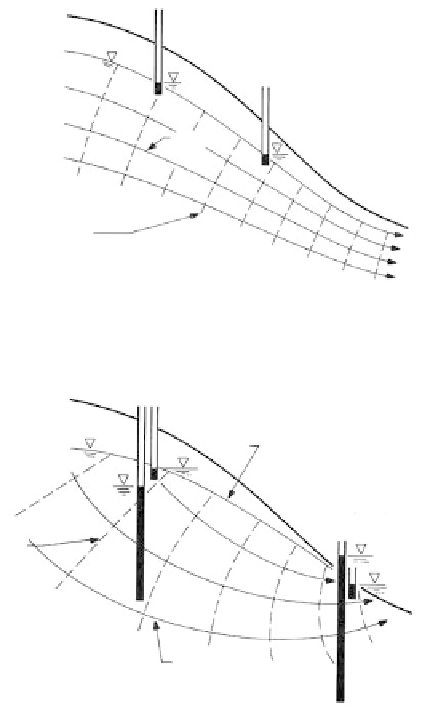Environmental Engineering Reference
In-Depth Information
GWT
Flow
line
Equipotential
line
(a)
Groundwater recharge area
(water levels decline with
increasing depth)
GWT
Groundwater discharge area
(water levels increase with
increasing depth)
Equipotential
line
Flow line
(b)
FIGURE 8.30
Comparison of the normal concept of groundwater flow in slopes with the more typical occurrence causing
instability: (a) groundwater flow assumed parallel to groundwater table (common in geotechnical literature,
but seldom found in practice) and (b) typical groundwater flow in slopes. (From Patton, F. D. and Hendron Jr.,
A. J.,
Proceedings of the 2nd International Congress,
1974.)
2. Slots, considered as a continuous line drain such as a stone-filled trench, or a line
of closely spaced wells such as a row of wellpoints
The two general types of wells are gravity or water-table wells, which penetrate uncon-
fined aquifers and artesian wells that penetrate confined strata.
Gravity Wells: Characteristics
Two cases of gravity wells are illustrated in
Figure 8.31;
in (a) the well fully penetrates an
unconfined aquifer and in (b) the well only partially penetrates the aquifer. The various
relationships pertaining to case (a) are described below; case (b), the partially penetrating
well, is described in Mansur and Kaufman (1962).
A cone of depression is produced in the water table surrounding the well as pumping
lowers the water level in the well and extracts water from the surrounding water-bearing
strata. Drawdown is the vertical distance between the original water table and the bottom
of the cone of depression. It can extend to horizontal distances from the well as much as
10 times the well depth, or greater, and under certain conditions it can result in ground
subsidence (see
Section 10.2).



